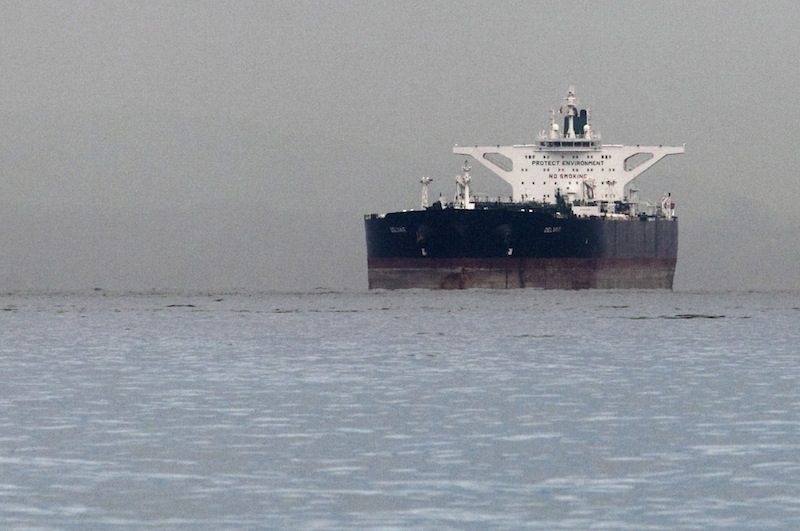Starmer Confident Aukus Pact Will Proceed Despite Trump Review
By Ellen Milligan Jun 15, 2025 (Bloomberg) –UK Prime Minister Keir Starmer said he has no doubts that the Aukus defense pact with the US and Australia will continue despite President...

A Malta-flagged Iranian supertanker is seen anchored off Singapore in this March 1, 2012 file photo. (c) REUTERS/Tim Chong
![]() By Alex Lawler and Jonathan Saul
By Alex Lawler and Jonathan Saul
LONDON, May 9 (Reuters) – Iran is using an Indonesian port in a strategy to keep up sales to buyers in Asia in the teeth of Western sanctions, according to shipping data and industry sources.
Two Iranian very large crude carriers (VLCCs) able to hold 2 million barrels each sailed to Batam Island in April, according to AIS ship tracking on Reuters, which tracks global tanker movements, before moving on to China.
U.S. and European sanctions aimed at pressuring Tehran’s suspected pursuit of nuclear weapons have halved Iran’s shipments, costing the government billions of dollars in oil revenue, since the start of 2012.
“Iran has been using this strategy for the past few months,” said analysts at FGE, an energy consultancy. “The strategy is taking the crude to islands in Asia via VLCCs and selling it from there. It’s a crucial stream of revenue for the country, so it’s very important they sell as much as they can.”
Batam Island is just 20 km (12 miles) off the south coast of Singapore, the continent’s oil hub. Industry sources and oil traders said that before last year it was rare for Iranian tankers to ship crude there.
“I think it is a staging post and crude goes from Batam to China or whatever,” said an official with a global oil company who declined to be named. “The Iranians can either keep the crude there, or leave it in the ground.”
Iran has shipped oil via other islands in Asia to help maintain exports. In September, Reuters reported Iran was parking oil at Labuan before shipping it on to other destinations.
“They have used Labuan in Malaysia in the past, so there is nothing really to stop them using Batam as a base as there are no sanctions-related drawbacks,” said a shipping industry source familiar with Iran’s tanker fleet and its movements.
“All of this is too risky for the brokers in the West or most ship owners, but it’s a live trade nonetheless.”
SAILING TO CHINA
The two tankers, Sonata and Courage, both belong to Iran’s top tanker operator NITC. They have sailed on to China after Batam, according to AIS.
NITC could not be immediately reached for comment, while an Iranian oil official declined to comment.
Another shipping industry source said there were indications based on ship tracking other tankers could also be involved in movements around Batam. Three tankers – Glaros, Seagull and Ocean Nymph – last reported their positions around the South China Sea area close to Indonesia several days ago, but have since not updated their positions.
The vessels were part of a fleet of eight tankers that were bought by a Greek middle man who was sanctioned earlier this year by Washington for operating a shipping network on behalf of Iran.
In April, the biggest buyer of Iranian crude was China, followed by South Korea, Japan, India, Turkey and Taiwan, according to estimates from industry sources. All of these buyers have cut their purchases over the last year.
Iran has reduced its oil exports to about 1.1 million barrels per day – worth roughly $3.3 billion a month at current prices – or about half of their rate at the start of 2012 before tighter sanctions kicked in.
With Iran more dependent on its own tankers to move oil because of sanctions, NITC vessels including Maharlika, Skyline and Demos have been making high-speed journeys to China and other Asian destinations from Iran to maxmimise flows, said a third shipping industry source.
“The average speed of the global fleet is anywhere between 8 to 11 knots at the moment,” the source said. “But of late some of the Iranian tankers have been making journeys around the 16 knots mark, which is even faster than at the highest point of the market in 2008.” (Editing by William Hardy)
(c) 2013 Thomson Reuters, Click For Restrictions

Sign up for gCaptain’s newsletter and never miss an update

Subscribe to gCaptain Daily and stay informed with the latest global maritime and offshore news


Stay informed with the latest maritime and offshore news, delivered daily straight to your inbox
Essential news coupled with the finest maritime content sourced from across the globe.
Sign Up